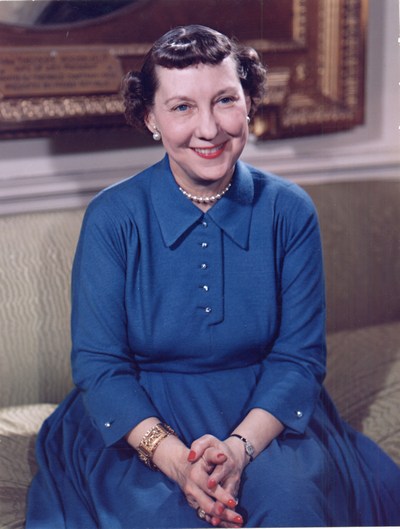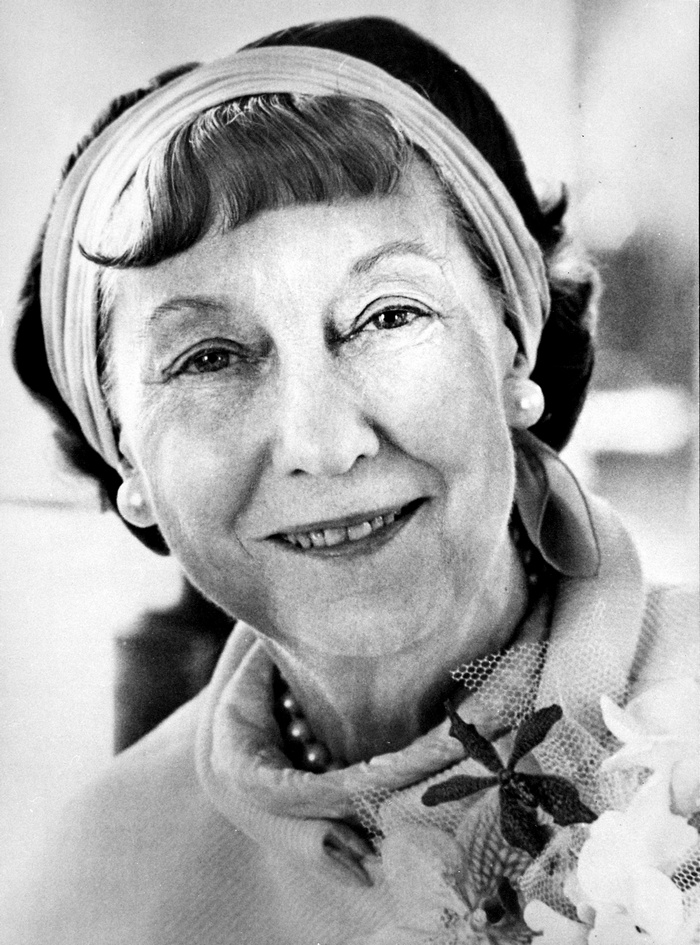Mamie Eisenhower (Mamie Eisenhower)

Born in Boone, Iowa and named, in part, after the popular song Lovely Lake Geneva, Mamie Geneva Doud was the second child born to John Sheldon Doud, a meatpacking executive, and his wife, the former Elivera Mathilde Carlson. She grew up in Cedar Rapids, Iowa, Colorado Springs, Colorado, Denver, Colorado, and the Doud winter home in San Antonio, Texas. Her father, who retired at age 36, ran a meatpacking company founded by his father, Doud & Montgomery (“Buyers of Live Hogs”), and had investments in Illinois and Iowa stockyards. Her mother was a daughter of Swedish immigrants. She had three sisters: Eleanor Carlson Doud, Eda Mae Doud, and Mabel Frances “Mike” Doud.
It was soon after completing her education at Miss Wolcott’s finishing school that she met Dwight Eisenhower at San Antonio in October 1915. Introduced by Mrs. Lulu Harris, wife of a fellow officer at Fort Sam Houston, the two hit it off at once, as Eisenhower, officer of the day, invited Miss Doud to accompany him on his rounds. On St. Valentine’s Day in 1916 he gave her a miniature of his West Point class ring to seal a formal engagement.
Lieutenant Dwight D. Eisenhower, aged 25, married Mamie Doud, aged 19, on July 1, 1916, at the home of the bride’s parents in Denver, Colorado. Following the wedding, performed by Reverend Williamson of the Central Presbyterian Church in Denver, the newlyweds honeymooned a couple days at Eldorado Springs, Colorado a resort near Denver, and then visited the groom’s parents in Abilene before settling into the lieutenant’s living quarters at Fort Sam Houston.
The Eisenhowers had two children (only one lived to adulthood):
Doud Dwight “Icky” (September 24, 1917 – January 2, 1921) died of scarlet fever.
John Sheldon Doud (August 3, 1922 – December 21, 2013) – soldier, diplomat, author. Born in Denver, Colorado, he graduated from West Point in 1944 and earned a master’s degree in English literature from Columbia University in 1950. After retiring from a military career (1944–1963), he was appointed ambassador to Belgium (1969–1971) by Richard Nixon. He authored three books: an account of the Battle of the Bulge: The Bitter Woods (1969); Strictly Personal (1974); Allies: Pearl Harbor to D-Day (1982).
For years, Mamie Eisenhower’s life followed the pattern of other Army wives: a succession of posts in the United States, in the Panama Canal Zone; duty in France, and in the Philippine Islands. Although accustomed to more creature comforts than those afforded at military posts, Mamie adjusted readily and joined her husband in moving 28 times before their retirement at the end of his term as president.
During the Second World War, while promotion and fame came to “Ike,” his wife lived in Washington, D.C. After he became president of Columbia University in 1948, the Eisenhowers purchased a farm (now the Eisenhower National Historic Site) at Gettysburg, Pennsylvania. It was the first home they had ever owned. His duties as commander of North Atlantic Treaty Organization forces—and hers as his hostess at a villa near Paris—delayed work on their dream home, finally completed in 1955.
They celebrated with a housewarming picnic for the staff from their last temporary quarters: the White House. Diplomacy—and air travel—in the postwar world brought changes in their official hospitality. The Eisenhowers entertained an unprecedented number of heads of state and leaders of foreign governments. As First Lady, she was noted for her outgoing manner, her love of pretty clothes, some of them designed by Scaasi, jewelry, and her obvious pride in husband and home. The gown she wore to her husband’s inauguration is one of the most popular in the Smithsonian National Museum of American History’s collection of inaugural gowns.
As First Lady, she was a gracious hostess but carefully guarded her privacy. A victim of Ménière’s disease, an inner-ear disorder that affects equilibrium, Mrs. Eisenhower was uneasy on her feet, which fed rumors that she had a drinking problem. Mrs. Eisenhower was known as a penny pincher who clipped coupons for the White House staff. Her recipe for “Mamie’s million dollar fudge” was reproduced by housewives all over the country after it was printed in many publications.
As described in multiple biographies, including Upstairs at the White House by J. B. West, Mrs. Eisenhower was reportedly unhappy with the idea of John F. Kennedy coming into office following her husband’s term. Despite new First Lady Jacqueline Kennedy having given birth to her son John Jr. via caesarean section two weeks prior, Mamie refused to inform Jacqueline that there was a wheelchair available for her to use while showing Mrs. Kennedy the various sections of the White House. Seeing Mamie’s displeasure during the tour, Jacqueline Kennedy kept her composure while in Mrs. Eisenhower’s presence, finally collapsing in private once the new First Lady returned home. When Mamie Eisenhower was later questioned as to why she would do such a thing, the former First Lady simply stated, “Because she never asked.”
In 1961 Mrs. Eisenhower retired with the former president to Gettysburg, Pennsylvania, their first permanent home. After her husband’s death in 1969, she continued to live full-time on the farm until she took an apartment in Washington, D.C., in the late 1970s. She appeared in a campaign commercial for her husband’s former Vice President Richard Nixon in 1972.
Mamie suffered a stroke on September 25, 1979. She was rushed to Walter Reed Army Medical Center, where Ike had died a decade before. Mamie remained in the hospital and on October 31, announced to her granddaughter Mary Jean Eisenhower that she would die the next day. Indeed, she died quietly in her sleep very early the morning of November 1, less than two weeks shy of her 83rd birthday. She was buried next to the president and her first son at Place of Meditation on the grounds of the Eisenhower Library in Abilene, Kansas. In 1980 her birthplace in Boone, Iowa, was dedicated as a historic site; Abigail Adams is the only other First Lady to be so honored. One of the east-west streets in Boone (Fourth Street) is now called Mamie Eisenhower Avenue.
Because of her connection with the city of Denver, Colorado and the area surrounding, a park in southeast Denver, Colorado was given Mamie’s name, as well as a public library in Broomfield, Colorado, a suburb of Denver.
Born
- November, 14, 1896
- USA
- Boone, Iowa
Died
- November, 01, 1979
- USA
- Washington D.C.
Cemetery
- Eisenhower Center
- Abilene, Kansas
- USA








